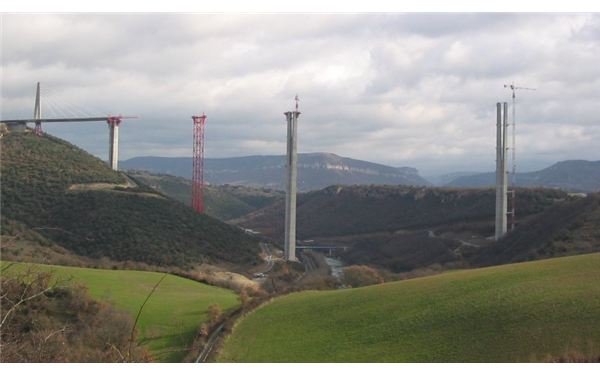Engineering Wonder: the Viaduc de Millau, France
Engineering Challenges
The Millau Viaduct was designed by structural engineer Michel Virlogeux and British architect Norman Foster. It forms part of the A75 autoroute from Clermont-Ferrand to Pézenas and links two limestone plateaus: the Causse du Larzac and the Causse Rouge. It was formally opened on December 16, 2004, much to the applause of motorists and local residents.
Prior to the construction of the viaduct, the only way to cross the Tarn River was the bridge at the bottom of the valley. During heavy traffic periods, motorists would sometimes wait for hours in traffic congestion to make the crossing. The Effage group was contracted to construct the bridge, still operating today. Under the government agreement that the company holds, tolls can be collected for crossing the bridge for up to 75 years.
It took fourteen years of research and three years of construction for the Millau Viaduct project to become a reality. The geography and weather conditions in the region made it very difficult for the engineers involved. The finished viaduct is constructed of an eight-span steel roadway supported by seven concrete pylons. The pylons, including temporary ones, were assembled first. Once they were in place the roadway was slid across the pylon from both sides by hydraulic rams. Finally, masts were erected on top of the pylons and connected to the deck. When the connections were completed, the temporary pylons were removed.
Before the construction of the viaduct, no building site ever used such a mixture of technologies in one location. Lasers, GPS, sliders, self-climbing formwork, high performance concrete, and other advanced materials all made the final bridge possible. In total, the project used 127,000 cubic meters of concrete, 19,000 metric tons of steel, and 5,000 metric tons of pre-stressed steel for the cables. The construction of the bridge cost €394 million. The viaduct has been a complete success and has even become a tourist attraction in its own right. In 2008, 4,670,449 vehicles crossed the Millau Viaduct. The bridge will provide motorists to the area a spectacular view and a quick journey for the foreseeable future. The contractor claims that the bridge’s lifespan will be at least 120 years.
A Steel Wonder
Considering the size of the bridge, its current weight of 242,000 tons is quite light to an expert design analyst. The steel framework of the bridge weighs only 36,000 tons. The reason lies in the use of steel over concrete. If the bridge was constructed of concrete, it would have weighed twice as much. Steel not only reduces the weight, but it is also less expensive. Moreover, the region surrounding the bridge is relatively dry, which means concrete construction would have required importing water from distant regions, thereby increasing the overall construction cost. Steel being recyclable in nature always ensures a return value, which is not possible with concrete. The steel structure did not require heavy foundations and needed fewer pylons and cables to support it, which also reduced the overall construction cost of the bridge.
A Record Breaking Bridge
The construction of the Millau Viaduct actually broke three world records. First of all, the bridge contains the highest pylons in the world. Pylons P2 and P3 are 244.96 meters and 221.05 meters, respectively. This world record was previously held by the Kochertal Viaduct in Germany, whose highest point is 181 meters.
The Millau Viaduct also has the highest bridge tower in the world. The mast that is on the top of pylon P2 is 343 meters high, which is slightly taller than the Eiffel Tower.
It also has the highest road bridge deck, which is 270 m above the Tarn River at its highest point. Only one bridge deck, the Royal Gorge Bridge in Colorado, is higher. At 321 m, it is consider the highest bridge in the world. The bridge was constructed in a record period of 38 months, which is a massive achievement considering the size, shape, and structure of the bridge.
This bridge is indeed an exceptional piece of civil engineering. It has become one of the most beautiful and most exciting monuments in France. The natural grandeur of the Aveyronnais landscape and the Gorges du Tarn surrounding it make it a wonderful treat for riders and adventurous people to ride in the countryside. This bridge is more than a simple work of civil engineering used by hurried travelers. Many people take the time to stop and look from a rest area upstream of the Millau toll house and enjoy the natural beauty of surroundings.
References
- Millau Steelbridge, Centre National de Ressources (pdf)
- Millau Viaduct by Matt Morioka, et al, Hawaii.edu
- Image Millau Viaduct, Wikipedia
